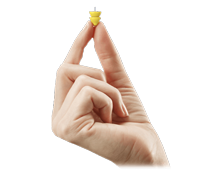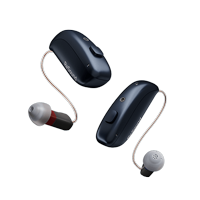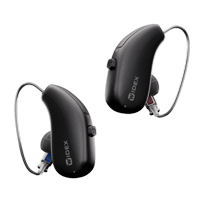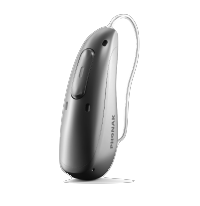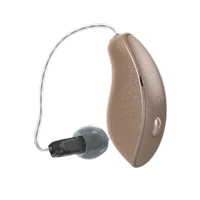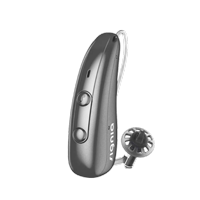How Do Hearing Aids Work: A Comprehensive Guide

Hearing aids are remarkable devices that have transformed millions of lives by reconnecting people with the world of sound around them. At California Hearing Center, we frequently meet patients who are curious about exactly how these sophisticated devices work to improve their hearing. Whether you’re considering hearing aids for yourself or a loved one, or simply interested in the technology, understanding the science behind these devices can help you make informed decisions about hearing healthcare. In this comprehensive guide, we’ll explore how modern hearing aids function, the different types available, and how to determine if they might be right for you.
The Basics of Hearing Aid Technology
At their most fundamental level, hearing aids are small electronic devices designed to amplify sounds, making them louder and clearer for people with hearing loss. However, today’s hearing aids are far more sophisticated than simple amplifiers – they’re highly advanced mini-computers that process sound in complex ways to deliver the best possible hearing experience.
All hearing aids, regardless of style or technology level, work through a similar process involving four key components:
1. The Microphone: Capturing Sound
Every hearing aid contains at least one microphone (and many modern devices contain multiple microphones). These microphones serve as the “ears” of the device, picking up sounds from the environment and converting these acoustic sound waves into electrical signals that can be processed by the hearing aid.
Advanced hearing aids often use directional microphone technology, which can focus on sounds coming from in front of you (such as a conversation partner) while reducing noise from other directions. This significantly improves speech understanding in noisy environments like restaurants or gatherings.
2. The Processor: The Brain of the Hearing Aid
Once the microphone captures sounds and converts them to electrical signals, these signals are sent to the processor – the most complex component of modern hearing aids. The processor is essentially a tiny computer that analyzes and modifies the sound signals based on sophisticated algorithms and the wearer’s specific hearing needs.
Modern digital processors can:
- Selectively amplify certain frequencies: Rather than making all sounds equally louder, digital processors can be programmed to amplify only the specific frequencies where a person has hearing loss
- Reduce background noise: Advanced noise reduction algorithms can identify and suppress unwanted background sounds while preserving speech clarity
- Eliminate feedback: Digital processing can prevent the whistling sounds that plagued older hearing aid models
- Adapt to different listening environments: Many modern hearing aids can automatically detect whether you’re in a quiet room, a noisy restaurant, or listening to music, and adjust settings accordingly
3. The Amplifier: Strengthening the Signal
After the processor modifies the sound signals, they’re sent to the amplifier. This component increases the power of the electrical signals, preparing them to be converted back into acoustic sound that’s loud enough for the wearer to hear clearly.
The amount and type of amplification provided depends on the specific hearing loss pattern of the user. For example, someone with mild high-frequency hearing loss might receive amplification primarily in the higher pitches, while someone with more severe, flat hearing loss might need substantial amplification across all frequencies.
4. The Receiver (Speaker): Delivering the Sound
The final component in the hearing aid signal path is the receiver (sometimes called the speaker). Despite its name, the receiver doesn’t actually receive anything – instead, it converts the amplified electrical signals back into acoustic sound waves and delivers them into the ear canal.
In some hearing aid styles, such as behind-the-ear (BTE) models, the receiver might be connected to the main device by a thin tube or wire. In other styles, like completely-in-canal (CIC) models, the receiver is integrated directly into the device body.
Types of Hearing Aids and How They Work
While all hearing aids follow the same basic principles described above, there are several different styles available, each with their own advantages and ideal use cases:
Behind-the-Ear (BTE) Hearing Aids
BTE hearing aids consist of a hard plastic case worn behind the ear, which contains the microphone, processor, and amplifier. Sound travels from the case through a tube or wire to an earpiece that fits in the ear canal.
Two common variations of BTE devices include:
- Traditional BTE: Uses a tube to conduct sound into an earmold that fits in the ear canal
- Receiver-in-Canal (RIC) or Receiver-in-the-Ear (RITE): Places the receiver directly in the ear canal, connected to the BTE unit by a thin wire. This design provides a more natural sound quality and reduces the visibility of the device
BTE hearing aids are typically the most powerful style and can address even severe hearing loss. They’re also often easier to handle for people with dexterity challenges.
In-the-Ear (ITE) Hearing Aids
ITE hearing aids fit completely in the outer ear (the bowl-shaped area of the ear). They’re custom-made to fit the unique shape of the wearer’s ear and contain all components within a single case. These devices are suitable for mild to severe hearing loss and often include features like directional microphones and volume controls.
In-the-Canal (ITC) and Completely-in-Canal (CIC) Hearing Aids
These smaller devices fit partly or completely into the ear canal. They’re less visible than other styles, making them popular with first-time hearing aid users who are concerned about appearance. However, their small size means they typically have fewer features, smaller batteries, and are suitable for mild to moderate hearing loss rather than severe cases.
Invisible-in-Canal (IIC) Hearing Aids
The smallest available hearing aids, IIC devices sit deeply in the ear canal, making them virtually invisible to others. Like other small hearing aids, they work best for mild to moderate hearing loss and may lack some of the advanced features of larger devices due to size constraints.
Advanced Features in Modern Hearing Aids
Today’s hearing aids go far beyond simple amplification, offering a range of sophisticated features that enhance the user experience:
Wireless Connectivity
Many modern hearing aids can connect wirelessly to smartphones, televisions, and other devices via Bluetooth technology. This allows users to stream calls, music, or TV audio directly to their hearing aids, essentially turning them into wireless headphones.
Companion smartphone apps often allow users to control volume, change programs, or even fine-tune hearing aid settings discreetly without touching the devices themselves.
Rechargeable Batteries
Traditional hearing aid batteries needed to be replaced regularly, which could be challenging for users with dexterity issues. Many modern devices now feature rechargeable batteries that provide all-day power with overnight charging, eliminating the need for frequent battery changes.
Telecoil Technology
Telecoils (T-coils) are tiny coils of wire in hearing aids that can pick up magnetic signals. This allows users to connect directly to compatible phone systems or hearing loop systems installed in theaters, auditoriums, and other venues, providing clearer sound by bypassing room acoustics and background noise.
Artificial Intelligence and Machine Learning
The most advanced hearing aids now incorporate AI and machine learning to continuously improve the hearing experience. These devices can learn the wearer’s preferences in different environments and automatically adjust settings accordingly. Some can even detect falls or track physical activity, serving as health monitoring devices in addition to hearing aids.
How Hearing Aids Are Programmed to Your Specific Needs
One of the most important aspects of hearing aid technology is that these devices aren’t one-size-fits-all solutions. Each person’s hearing loss is unique, and hearing aids must be properly programmed and fitted to address individual needs.
The Audiogram: The Blueprint for Programming
Programming begins with a comprehensive hearing evaluation, which produces an audiogram – a graph showing which frequencies a person can hear at various volume levels. This audiogram serves as a map for programming the hearing aid, indicating which sounds need more amplification and which don’t.
Real Ear Measurement: Verifying Performance
After initial programming based on the audiogram, audiologists often perform real ear measurement (REM) to verify that the hearing aids are providing the right amount of amplification. This involves placing a tiny microphone in the ear canal to measure the actual sound delivered by the hearing aid and comparing it to prescription targets.
Fine-Tuning Based on User Feedback
Beyond the audiogram and objective measurements, your feedback as a hearing aid user is crucial for optimal programming. During follow-up appointments, audiologists make adjustments based on your real-world experiences, ensuring the hearing aids work well in your specific listening environments.
Are Hearing Aids Right for You?
Understanding if you might benefit from hearing aids starts with recognizing the signs of hearing loss:
- Frequently asking people to repeat themselves
- Feeling like others are mumbling
- Difficulty hearing in noisy environments
- Turning up the TV or radio louder than others prefer
- Trouble hearing on the telephone
- Withdrawing from social situations due to communication difficulties
If you experience these symptoms, a comprehensive hearing evaluation is the first step. This painless assessment will determine if hearing aids could help and, if so, which type might be most appropriate.
The Adjustment Period: Getting Used to Hearing Aids
When you first start wearing hearing aids, you may be surprised by how things sound. This is because your brain needs time to readjust to hearing sounds it hasn’t perceived in a while. Common experiences during the adjustment period include:
- Your own voice sounding different or louder
- Being more aware of background noises like refrigerator hums or air conditioning
- Feeling that some sounds are too sharp or tinny
Most people adapt to these new sounds within a few weeks, and audiologists can make adjustments during this period to improve comfort. Consistent wear is key to successful adaptation – the more you wear your hearing aids, the faster your brain will adjust to them.
Caring for Your Hearing Aids
To ensure your hearing aids continue working properly, regular maintenance is essential:
- Clean your hearing aids daily with a soft, dry cloth
- Keep hearing aids away from heat and moisture
- Remove hearing aids before showering, swimming, or using hair products
- Change batteries regularly (if not using rechargeable devices)
- Schedule regular professional cleanings and check-ups
Proper care can significantly extend the life of your hearing aids, which typically last 5-7 years with good maintenance.
Conclusion
Modern hearing aids represent an incredible marriage of acoustical science, digital technology, and personalized healthcare. Far from the simple amplifiers of the past, today’s devices use sophisticated processing to deliver clear, natural sound tailored to each user’s unique hearing profile.
If you’re experiencing hearing difficulties, don’t wait to seek help. Unlike vision loss, which people typically address promptly, hearing loss is often ignored for years before treatment is sought. Unfortunately, this delay can lead to auditory deprivation – when the brain loses some of its ability to process certain sounds due to lack of stimulation.
At California Hearing Center, we’re committed to helping you understand your hearing health and find the best solutions for your needs. Our experienced audiologists can guide you through the process of selecting, fitting, and adjusting to hearing aids, ensuring you receive the maximum benefit from these remarkable devices.
Turning Life up Through Better Hearing
For over 30 years, California Hearing Center has been helping people improve their lives through better hearing. Our team of experienced audiologists offers comprehensive hearing evaluations, personalized hearing aid fittings, and ongoing support to ensure you get the most from your hearing technology. Don’t let hearing loss disconnect you from the people and activities you love.
Or call us at (650) 342-9449
This article is for informational purposes only and does not constitute medical advice. Always consult with a qualified healthcare professional about your specific situation.


